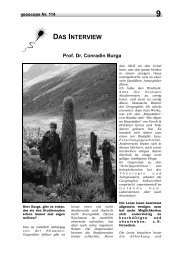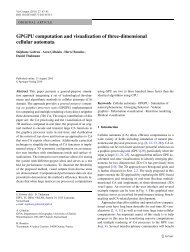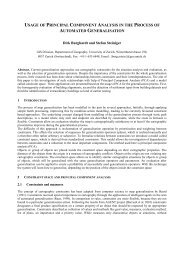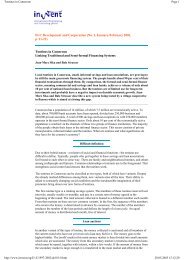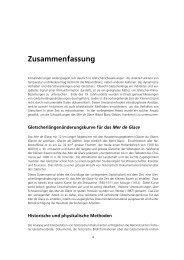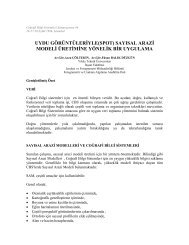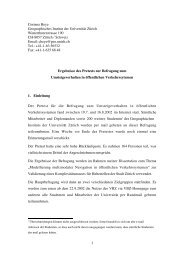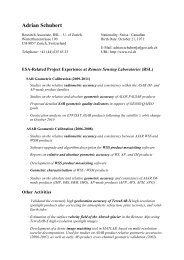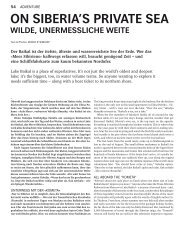KYRGYZSTAN TODAY Policy briefs on - Department of Geography
KYRGYZSTAN TODAY Policy briefs on - Department of Geography
KYRGYZSTAN TODAY Policy briefs on - Department of Geography
Create successful ePaper yourself
Turn your PDF publications into a flip-book with our unique Google optimized e-Paper software.
force and its pr<strong>of</strong>ile, since all the enterprises were public. Informati<strong>on</strong> <strong>on</strong> the balance<br />
<strong>of</strong> labor resources was based <strong>on</strong> a strict system <strong>of</strong> reports prepared by each enterprise.<br />
With the emergence <strong>of</strong> the private sector, a “black labor market” and other changes<br />
that accompanied the transiti<strong>on</strong>al ec<strong>on</strong>omy, old methods no l<strong>on</strong>ger reflected the real<br />
picture, yet new methodology and tools for analyzing the labor market were not yet<br />
developed.<br />
The Nati<strong>on</strong>al Statistical Committee <strong>of</strong> the Kyrgyz Republic, with support from<br />
DFID, c<strong>on</strong>ducted a labor force research in 2002. Based <strong>on</strong> household data, it was the first<br />
research that used a new methodology for analyzing employment and labor throughout<br />
the country. Unfortunately, such studies have not become systematic. Unsurprisingly,<br />
currently labor market analyses are based <strong>on</strong> very rough estimates or judgments, not <strong>on</strong><br />
more-reliable statistics.<br />
For similar reas<strong>on</strong>s, studies <strong>of</strong> foreign labor markets face even worse c<strong>on</strong>diti<strong>on</strong>s.<br />
These are mostly a variety <strong>of</strong> research projects supported by internati<strong>on</strong>al organizati<strong>on</strong>s.<br />
Such projects are clearly valuable when there is a general lack <strong>of</strong> informati<strong>on</strong> and data.<br />
However, they tend to have a particular focus, narrow scope and limited resources,<br />
as well as imperfect methodologies, because <strong>of</strong> the novelty <strong>of</strong> the issue and various<br />
organizati<strong>on</strong>al difficulties. In the same way, almost no organizati<strong>on</strong>s m<strong>on</strong>itor the<br />
dynamics <strong>of</strong> the labor markets.<br />
Private employment agencies in labor-exporting countries play an important<br />
role as intermediaries in the labor market, and possess informati<strong>on</strong> and tools for<br />
analyzing foreign labor markets. Kyrgyzstan has few employment agencies, which are<br />
not instituti<strong>on</strong>ally developed and do not always have the necessary informati<strong>on</strong> and<br />
links to employers. In most cases, their resources are insufficient to maintain affiliates<br />
in recipient countries, or to keep c<strong>on</strong>stant c<strong>on</strong>tact with the employers there. Another<br />
difficulty is that private employment agencies, which face bureaucratic obstacles to their<br />
work, must <strong>of</strong>ten work illegally. Thus, Kyrgyzstan has few effective tools for analyzing<br />
labor markets as the basis for a sound policy <strong>of</strong> labor export.<br />
Efforts to train competitive pers<strong>on</strong>nel, with the knowledge and skills demanded<br />
and recognized in recipient countries, also experience many problems. A recent ILO<br />
study <strong>of</strong> the use <strong>of</strong> human resources has c<strong>on</strong>ducted interviews with employers in<br />
Moscow, Yekaterinburg, Almaty and Astana. Employers were asked which trades<br />
are in demand, the extent <strong>of</strong> the gap between demand and supply <strong>of</strong> workers in these<br />
occupati<strong>on</strong>s, whether they empoy citizens <strong>of</strong> Kyrgyzstan, which types <strong>of</strong> work the<br />
migrants do, whether qualificati<strong>on</strong>s granted in the emigrants’ nati<strong>on</strong> are recognized, etc.<br />
Judging from the resp<strong>on</strong>ses to this survey, the trades in greatest demanded in Russia<br />
and Kazakhstan are c<strong>on</strong>structi<strong>on</strong> workers, housing and communal services, catering<br />
and clothing manufacture.<br />
The list <strong>of</strong> occupati<strong>on</strong>s in demand am<strong>on</strong>g Kyrgyzstan’s employers was very similar.<br />
It is interesting that, in the domestic market, demand for many trades is <strong>on</strong>ly partially<br />
satisfied, and employers c<strong>on</strong>stantly complain that there are not enough workers <strong>of</strong><br />
many pr<strong>of</strong>essi<strong>on</strong>s. Thus, the domestic labor market in Kyrgyzstan essentially competes<br />
with the labor markets in the CIS countries in trying to get workers with comparable<br />
skills. Kyrgyzstan loses in this competiti<strong>on</strong> because it loses desirable human resources<br />
to foreign labor markets where the pay is several times higher, although this pay does<br />
not meet the expectati<strong>on</strong>s <strong>of</strong> migrant workers.<br />
However, the ILO study raises the paradox that employers in Kyrgyzstan, despite<br />
complaining about a shortage <strong>of</strong> workers, are unwilling to pay higher wages. Proposed<br />
103






